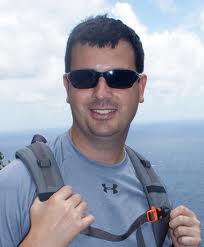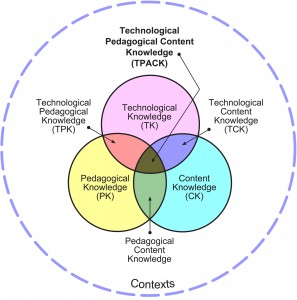 Charles E. Gramatges has recently been appointed Head of Middle School at St. Thomas’ Episcopal in Houston, Texas. Until very recently, he was a middle school mathematics teacher at St. John’s School in Houston, teaching 6th and 7th grade pre-algebra, coaching varsity lacrosse, and serving as an advisor to 14 sixth grade students. He writes: “I am very interested in academic innovations via technology and in the great outdoors. From camping to iPads, I thoroughly enjoy discussing ideas regarding ways to stretch the minds of young men and women.” Follow Charlie @cgramatges
Charles E. Gramatges has recently been appointed Head of Middle School at St. Thomas’ Episcopal in Houston, Texas. Until very recently, he was a middle school mathematics teacher at St. John’s School in Houston, teaching 6th and 7th grade pre-algebra, coaching varsity lacrosse, and serving as an advisor to 14 sixth grade students. He writes: “I am very interested in academic innovations via technology and in the great outdoors. From camping to iPads, I thoroughly enjoy discussing ideas regarding ways to stretch the minds of young men and women.” Follow Charlie @cgramatges
by Charlie Gramatges
One of the biggest fears I have as I move into my first full-time administrative role in a school is being ready to handle the unexpected. A very wise and much more experienced school leader told me that the best advice given to him was to “expect five unexpected things every day — because then they won’t be unexpected.”
That’s a pretty comforting statement. Even the most experienced school leader will see curveballs come over the plate day in and day out. It’s like we teach our students: we are going to make mistakes; what matters is learning from them. That willingness to step back, analyze and reflect is the difference between those who succeed and those who are still struggling to do so.
This fall, I will begin the academic year in a new position, as Head of Middle School at St. Thomas Episcopal in Houston, Texas. I’m making the shift to full-time administration after a nine-year independent school career that’s included teaching, coaching, and working in part-time leadership roles. Serving as Head of Middle School is the exciting next step I will take to impact the lives of young men and women during what I believe to be the most critical time in their personal development as learners and citizens.
As I try to wrap my brain around the monumental change that is taking place in my professional life, I’ve been thinking back on my year as a participant in Powerful Learning Practice’s Connected Learner Experience and what the most important first steps in this new leadership role might be.
The task of leading an entire division can seem insurmountable; there are so many areas on which I can focus. How do I choose some and risk letting others languish? How do I choose the path that leads to success, one that marks my leadership as edifying and inspiring over the next year (or the first few weeks, for that matter)?
As I read that last paragraph, it may appear that I’m having a mini-panic attack. So let me gather my wits, “screw my courage to the sticking place,” to quote a favorite line from Shakespeare and a great Disney movie, and refocus.
I can do this.
Let’s start at the very beginning (it’s a very fine place to start)…
While many issues arise that are best facilitated by experience, new leaders don’t have the luxury of waiting to accumulate time in the director’s chair before addressing them. Sheryl Nussbaum-Beach, CEO of Powerful Learning Practice, holds steadfast to the mantra that educators must dedicate their own professional development to hone skills as learners first if they hope to bring the best and most dynamic methods of delivering concepts to the classroom.
The same story goes for division heads: in order to direct a division, leaders must become experts in their field by researching best practices and learning the best way to transfer these strategies to their staff.
One of my favorite “learnings” from my first year in the PLP Connected Learner Experience has been in a growing understanding of the TPACK framework. I appreciate the concept of a “framework”: the structure created behind the scenes, allowing for consistency and security when times are chaotic. Most of the development of this framework exists for the purpose of curriculum planning for a subject; I have found very little information about how to use TPACK to guide a division or school.
In my first year as an administrator, I’m going to attempt to tweak the TPACK model to integrate leadership concepts such as divisional guidance and teacher empowerment by using tried and true techniques and by incorporating new “tech” tools for communication and professional development of the faculty I will lead.
The TPACK Model: Fine-Tuning It for Leadership
 The Technological, Pedagogical, and Content Knowledge framework, or TPACK, combines the knowledge teachers need to teach effectively while utilizing technology (Mishra & Koehler, 2006). For most teachers, TPACK helps to pave a path for introducing technology in a curriculum that has been in practice for years. Technology is the rapidly increasing piece of the puzzle to engage the modern-day learner. Teachers must research and understand how technology-based tools may enhance the delivery and exploration of a topic in the classroom.
The Technological, Pedagogical, and Content Knowledge framework, or TPACK, combines the knowledge teachers need to teach effectively while utilizing technology (Mishra & Koehler, 2006). For most teachers, TPACK helps to pave a path for introducing technology in a curriculum that has been in practice for years. Technology is the rapidly increasing piece of the puzzle to engage the modern-day learner. Teachers must research and understand how technology-based tools may enhance the delivery and exploration of a topic in the classroom.
While most of the time the TPACK framework is used to redevelop the classroom environment, the same opportunity should exist for administrators looking for a macro-perspective on how they might manage a school or division with the framework in mind. I believe that the better equipped an administrator is to incorporate technology into the typical programs and processes he or she directs, the easier it will be to encourage faculty and staff to integrate technology into the classroom.
For this reason, I’m spending much of my summer working to find ways to better integrate faculty planning, cross-curricular development, and basic communication via email. One a-ha moment that I have already realized: if an administrator expects participation by faculty in utilizing a technology tool, the path to entry must be smooth as silk. If there are barriers to entry (creating login information, multiple clicks, small fonts), then many teachers will simply balk.
Idea #1: Interactive Weekly Updates
Every day will be a first day for me as an administrator in the 2013-2014 school year. Being able to adapt and to learn “on the fly” will be a key component to my success; however, there are many things I can do to be a great learner during this next adventure. All pieces begin and end with dedication to learning and removing assumptions.
After a few weeks of planning and considering how the TPACK framework will extend into my administrative role, I have come up with ideas of implementation. They are merely untested applications at this point, but here’s the first one I would like to see developed within the faculty of my new school. I’d love your feedback.
Idea #1: Most division heads already make an effort to update their faculty about weekly activities. As a teacher, I appreciated these notifications as they itemized events and to-do lists each week. I needed the reminders; my calendar needed the weekly refresh.
However, the information was always a one-way street. I think there can be more to this line of communication. Why not create a “principal’s blog” that will itemize all of these weekly updates with the additional functionality of interactive discussion? For instance, if there is a note about the recent success of the debate team, or a championship won by the basketball team, faculty can contribute when they attended the event to give the description a more personal touch.
Also, the principal can see concerns that may arise when a new program is about to begin; and answer those questions in a location everyone can reference. Often I have found that a new initiative sparks many questions from teachers that go unanswered, creating inconsistency in implementation. This interactive newsletter would provide a venue for the dissemination and discussion of this information and very valuable as we explore TPACK.
Whether this interactive weekly update is offered via a Google Doc or in another, easy-to-use application, the concept of a two-way communication channel would help further strengthen the leader/teacher relationship and help us all do our work more effectively.
Please share your ideas via comments. As I develop these various components to my role, the more I can discuss them with other experts in the field (i.e., YOU), the better the pieces will fit together. I look forward to that discussion!
John Norton
Latest posts by John Norton (see all)
- I'm a "Learner First" in a Whole New World - July 1, 2013
- Hale@home: Easing Student Transitions via Online Learning - May 17, 2013
- Our Top 13 Voices Posts for 2012! - January 1, 2013


Trackbacks/Pingbacks